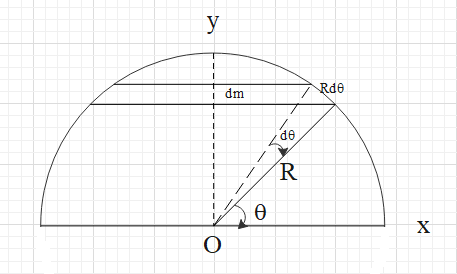Question
Question: Find the centre of mass of a uniform hollow hemisphere of radius R....
Find the centre of mass of a uniform hollow hemisphere of radius R.
Solution
Consider a small ring element of the hemisphere, which makes an angle θ with the positive x-axis. Use the formula for the centre of mass of a system of particles. Assume that the hemisphere has uniform mass distribution and find the mass of the small element.
Formula used:
ycom=M∫dmy
σ=2πR2M
Complete answer:
Consider a hollow hemisphere of radius R as shown.
Due to symmetry, the x coordinate of the centre of mass of this surface will be zero.
Let us find the y component of the centre of mass.
For this, consider a small element of the hemisphere in a ring, as shown in the figure.

Let this ring make an angle θ with the positive x-axis and the width of this ring element subtend a small angle dθ at the origin.
The radius of this will be Rcosθ and the width will be equal to Rdθ (from the arc-length formula).
Now, centre of mass of a system of small elements is given as ycom=M∫dmy …(i)
Here, y is the position of the ring element on the y-axis, dm is the mass of this element and M is the total mass of the hemisphere.
To find dm, let us assume that the mass of the hemisphere is uniformly distributed. Therefore, it will have a uniform surface mass density.
The surface mass density of the hemisphere will be σ=2πR2M.
The surface mass density of the ring element will be σ=2πRcosθ(Rdθ)dm
⇒σ=2πRcosθ(Rdθ)dm=2πR2M
⇒cosθdθdm=M
⇒dm=Mcosθdθ
From the figure we get that y=Rsinθ
Substitute the values of dm and y in (i).
ycom=M∫Mcosθdθ(Rsinθ)
⇒ycom=R∫cosθsinθdθ.
The limits of θ will be from 0 to 2π.
⇒ycom=R0∫π/2cosθsinθdθ …. (ii)
We know that sin2θ=2cosθsinθ.
⇒cosθsinθ=2sin2θ
Substitute this value in (ii).
⇒ycom=R0∫π/22sin2θdθ
⇒ycom=2R0∫π/2sin2θdθ
⇒ycom=−2Rcos2θ∣0π/2=−2R(cos2π−cos(0))
⇒ycom=−2R(0−1)=2R.
Therefore, the centre of mass of the hollow hemisphere is (0,2R).
Note:
Students can make a mistake in writing the limits of the angle θ. Some students may consider the limits of θ from 0 to π.
Note that we are considering small ring elements of the hemisphere. So the rings will start from the bottom of the hemisphere when the angle is zero. And the angle increases, we get the other rings. Therefore, at the ring element (at the top) the angle will be equal to 2π.
